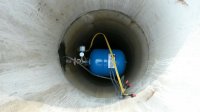Hi everyone. I am new here but was hoping to get some ideas about the best way of going about setting up my water line for my new 70 foot greenhouse.
I have a few wells on my farm, and just installed a new 80x30 high tunnel greenhouse. The well that is closest to the greenhouse is tied to a building that I use for storage. The building has a furnace, but I don't heat it in the winter.
I put a pump in the building last fall to get the water going, and I drained it in the winter so it wouldn't freeze, but today when I fired it up water leaked out the bottom so apparently the pump froze.
The greenhouse is 20 feet from the building. I was planning to run a poly line from the outside of the building, trenched down 4 feet underground to the greenhouse where it would connect to a frost proof hydrant.
My problem remains though, how do I set it up so that the pump won't freeze in the winter. I could get rid of the pump in the building and put it in the greenhouse which will rarely dip below freezing, but how would it remain primed unless the water line goes directly to the well and not up into the building before connecting over to the greenhouse?
Any ideas would be appreciated. I am including a diagram of how I was going to set it up though I don't think it will work without heating the building.
I have a few wells on my farm, and just installed a new 80x30 high tunnel greenhouse. The well that is closest to the greenhouse is tied to a building that I use for storage. The building has a furnace, but I don't heat it in the winter.
I put a pump in the building last fall to get the water going, and I drained it in the winter so it wouldn't freeze, but today when I fired it up water leaked out the bottom so apparently the pump froze.
The greenhouse is 20 feet from the building. I was planning to run a poly line from the outside of the building, trenched down 4 feet underground to the greenhouse where it would connect to a frost proof hydrant.
My problem remains though, how do I set it up so that the pump won't freeze in the winter. I could get rid of the pump in the building and put it in the greenhouse which will rarely dip below freezing, but how would it remain primed unless the water line goes directly to the well and not up into the building before connecting over to the greenhouse?
Any ideas would be appreciated. I am including a diagram of how I was going to set it up though I don't think it will work without heating the building.
Last edited by a moderator:

